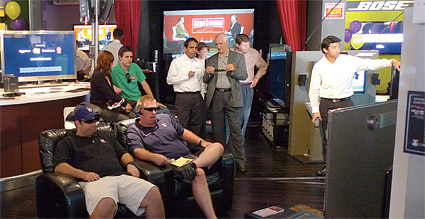3DTV: Homeless for the Holidays?
ALEXANDRIA, VA.
There's good news and not-so-good news for proponents of 3DTV for this holiday sales season that traditionally (if not quite accurately) peaks on Black Friday. The good news is the year that 3DTV sales begin to make a major impact in the United States could be in sight.
The not-so-good news is that "year" will not be 2010, or maybe even 2011.

Samsung held a private 3D showcase for its latest 3D LED TVs in Santa Monica, Calif. recently. Perhaps one telling sign the next two months will not provide any dramatic launch window for 3DTV sets in America is the fact that set manufacturers seem far more eager to discuss their "Internet TV" plans for the approaching holidays than anything else. Web-enhanced HD sets boasting internal software like Google TV and attachable hardware like Apple TV will flood retail shelves for the holidays.
Bolstering this scenario is a late October report from analyst DisplaySearch: "While much of the news coverage surrounding TV concentrates on 3D, the quiet revolution of connected TV is reaching new heights with over 40 million units expected to ship in 2010." 3DTV's presence, for its part, will emerge in a waiting-in-the-wings sort of way.
"There will probably be minimal impact since 3D is not yet in the mainstream of the TV market," said Paul Semenza, senior vice president for analyst services at DisplaySearch. "For high-end consumers, where price is less of a concern, we do expect interest in 3D capability in order to 'future-proof' their purchases."
But 3DTV sales are not predicted to remain below retail's radar for terribly long. DisplaySearch is also forecasting "tremendous growth in 3DTV shipments" over the next few years. Its recently revised long-range projections for global sales call for 18 million 3DTV sets to be shipped in 2011. By 2014, a more dramatic jump to over 90 million units shipped worldwide is envisioned.
CONTENT & QUALITY

Paul Semenza, senior vice president for analyst services, DisplaySearch. But if conventional wisdom currently maintains that 3DTV sets will not be a big seller this holiday season in America due to the fact that many TV households recently invested in HDTV sets, that doesn't cut it with Semenza. "The fact that many consumers might have purchased [HD] sets over the past few years is not the main impediment to 3DTV—especially since many consumers have yet to step up to 40-plus inch, flat-panel sets, which is where 3D [becomes] available. Rather, it's a lack of content and concerns about quality, as well as the costs and inconvenience of current shutter glasses-based 3D [usage]," Semenza said.
While the annual consumer "holiday wish list" of electronic products released in October by the Consumer Electronics Association does not even list 3DTV in its Top 10, the CEA concurs with DisplaySearch on at least one key point. "Our research suggests individuals interested in 3DTV are not largely influenced by when they purchased their last TV," said Shawn DuBravac, CEA chief economist and director of market research.
"New [product] categories often see 50 percent or more of their annual volume in the fourth quarter," DuBravac said. "We expect the same for 3D. It's progressing exactly like we'd expect it to. Technology always follows an 'S' shape adoption curve. Adoption isn't linear. Things start slowly before accelerating at an increasing rate, and 3DTV will do the same."
Best Buy, the nation's largest CE retailer, acknowledges that TV sales of all kinds were a bit subdued in the first half of the year, but "it's going to get a lot more exciting here in the second half," said a spokesman. "Overall, the industry had higher expectations for 3D than what we're seeing now, but we think that's more of a marketing problem.
"Both in the stores and in the way everyone is advertising, you get the concept that that's all [3DTV sets] can do—play 3D," said the Best Buy spokesman. "That's limiting consumer awareness and understanding of the product…We'll do a good job this holiday of improving consumer awareness…that 3D is [only one] feature of a TV set, as opposed to its sole function."

Shawn DuBravac, chief economist and director of market research, CEA While a new type of 3DTV sans the active shutter-wear glasses are in the works from the likes of Toshiba, Sharp, Philips, Samsung and LG, none of these new products will affect the coming holiday sales season in America. Semenza finds Toshiba's possible breakthrough intriguing, but said "it's also noteworthy the [Toshiba] screen sizes will be quite small, which will limit the 3D effect." Initial screen sizes in Toshiba's new Glasses-less 3D REGZA-GL1 Series will be a modest 12- and 20-inches, with MSRP for the larger unit at nearly $3,000.
MORE CONTENT ON THE WAY
Chris Fawcett, vice president for Sony U.S. television, thinks 3DTV will still manage to create some excitement at the retail level this holiday season. "Sales will pick up momentum in the next two months as more 3D content streams into the market," he said. Helping drive interest will be 3D games and broadcasts, 3D Blu-ray discs, and personal 3D content from digital cameras, he said.
As for a lingering troubled economy, Fawcett said "televisions, Blu-ray players and home audio devices have demonstrated resilience in weathering economic storms, and what better to do in 'stormy times' than stay home and watch TV?"
Panasonic Vice President Peter Fannon said Sony's competitor expects "3DTV sales to continue to be very solid, as they have been since our late-spring launch, despite still-tough economic times and careful [consumer] spending." As the holiday season approaches, Fannon said market opportunity for buying 3DTV sets and Panasonic's 3D Blu-ray player could affect two-thirds of America's 115 million TV households. Panasonic bases this "two-thirds" assumption on generally accepted guesstimates that 30 percent or more of households still do not own HD sets—and another 30 percent or more own HD sets that are several years old and getting ready for replacement.
As for price-point strategies heading toward Black Friday, Fannon said "new full-featured 3DTVs are vastly less expensive in real current dollars than the early HDTVs and even those big-screen NTSC sets when first launched years ago. Now it's not the DTV 'transition complexity' of when we went analog-to-digital. Now it's simply getting the new 3DTV and eyewear, and connecting it to your existing HD set-top box, which may have been automatically provisioned undefined for 3D."
Get the TV Tech Newsletter
The professional video industry's #1 source for news, trends and product and tech information. Sign up below.
